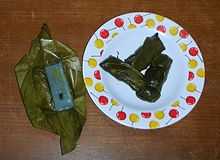For the similarly named rice congee and rice soup in Thai cuisine, see
Congee.
| Khao tom |
|---|
|
Dessert |
Khao tom, can be either savory or sweet. This one from Laos, with a pork fat and mung bean filling, is savory. |
| Alternative name(s): |
|---|
|
Kao tom |
| Place of origin: |
|---|
|
Laos and Thai |
| Main ingredient(s): |
|---|
|
sticky rice, banana leaves |
| Recipes at Wikibooks: |
|---|
 Khao tom Khao tom |
| Media at Wikimedia Commons: |
|---|
 Khao tom Khao tom |
Khao tom (Lao: ເຂົ້າຕົ້ມ; Thai: ข้าวต้ม, pronounced [kʰâw tôm]; also spelled Kao tom) is a Laotian and Thai dessert of seasoned steamed sticky rice wrapped in banana leaves.[1]
Variants
This dessert can be either savory (filled with pork fat and mung bean) or sweet (filled with coconut milk and banana). In Thailand, khao tom is sometimes colored blue with Clitoria ternatea flowers.
The khao tom variety with black beans is known as Khao tom mat (ข้าวต้มมัด).[2]
Traditions
The Sai Krachat Tradition (ประเพณีใส่กระจาด), also known as Suea Krachat or Soe Krachat in Phuan language is a merit-making Buddhist tradition of the Thai Phuan people of in Ban Mi District, Lopburi Province. It takes place on the eve of the Great Birth Sermon celebration. One day prior to the Sai Krachat Day, people will wrap Khao tom and grind rice for Khao pun rice noodles. The next day is the Sai Krachat Day when people will bring things such as bananas, sugar cane, oranges, candles and joss sticks or other items to put into the bamboo baskets at the houses of the people they know, while the hosts will bring the prepared food to welcome their guests. When the visitors wish to go home, the host will give Khao tom mat as a souvenir in return called “Khuen Krachat”.[3]
See also
References
External links
 Media related to Khao tom (dessert) at Wikimedia Commons
Media related to Khao tom (dessert) at Wikimedia Commons
|
|---|
| | Staples / Entrees | |
|---|
| | Soups / Stews | |
|---|
| | Salads / Wraps | |
|---|
| | Snacks / Desserts |
- Nam waan
- Khao tom
- Kaipen
- Khanom mor gaeng
- Khanom sun
- Sticky rice with mango
- Vun
|
|---|
| | Beverages | |
|---|
| | Condiments | |
|---|
| | Utensils |
- Khok
- Saak
- Huad
- Mor nung
- Mor kharng
- Mor gaeng
|
|---|
|
|
|---|
| | Individual dishes | |
|---|
| | Shared dishes | |
|---|
| | Isan dishes | |
|---|
| | Snacks and desserts | |
|---|
| | Miscellaneous | |
|---|
| | Beverages | |
|---|
| | See also | |
|---|
|


![]() Media related to Khao tom (dessert) at Wikimedia Commons
Media related to Khao tom (dessert) at Wikimedia Commons